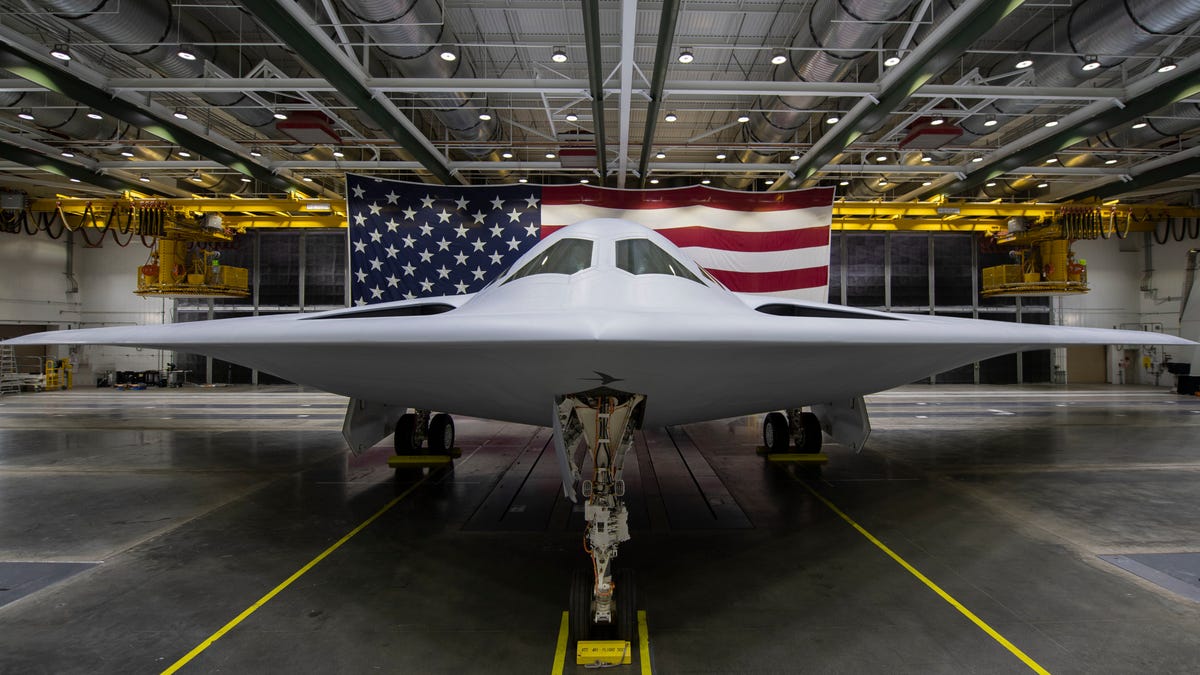US Air Force Unveils B-21 Bomber After Marking 75th Anniversary
In September, the Air Force turned 75. Here's a look at its origins, its aircraft over the decades and the cutting-edge B-21 poised to join its ranks.

A B-21 Raider in a Northrop Grumman hangar in Palmdale, California, on Dec. 2, 2022, at its public unveiling.
The US Air Force was born 75 years ago, at the dawn of a new era of aviation that brought jet aircraft, nuclear weapons and supersonic flight. This month, it unveiled the B-21 Raider, the first strategic bomber it's introduced since the end of the Cold War more than three decades ago. (More on that below.)
But the Air Force was a thing long before we knew it by that name. For four decades – from the everything-is-new days of the Wright brothers through the hellish aerial combat of World War II – the American military flew scores of different aircraft and countless missions. In large part, those flyers served as members of the US Army.
Then, two years after the end of World War II, came the National Security Act of 1947. The act, which President Harry Truman signed on July 25 of that year, decreed that the Air Force should be its own separate branch of the US military, effective two months later, on Sept. 18.
The Air Force had barely begun its new bureaucratic existence when it recorded a remarkable aerial achievement: Capt. Chuck Yeager breaking the sound barrier in the X-1 aircraft, in October 1947. But more workaday designs were the norm, like the older C-47 Skytrain, an emissary of hope and rations for those bottled up in a divided city during the Berlin Airlift, and soon the B-36 and B-52 bombers, avatars of the Cold War doctrines of massive retaliation and mutually assured destruction.
In more recent decades, the Air Force has been at the cutting edge of aviation with stealth aircraft including the F-117 Nighthawk and B-2 Spirit, with the Predator and Reaper drones, and with the secretive X-37B space plane. In a sign of how significant missions outside the atmosphere have become, the US Space Force was spun off from the Air Force in late 2019.
The first slideshow, above, takes a look back through 75 years of US Air Force aircraft. The second, below, features the 40 years of aircraft that came first. (No disrespect, of course, to the many aviators of the US Navy. Here, though, we're focusing on the branch dedicated to air superiority.)
The precursors
Before 1947, the precursors to the US Air Force went by many names. It all began with, of all things, the Army Signal Corps. In the earliest years of powered, heavier-than-air aircraft after the Wrights flew at Kitty Hawk, people looked to flying machines – balloons and dirigibles included – as observation platforms more than as weapons.
Here's how the organization's naming went over the years before Washington created the US Air Force: the Aeronautical Division (1907-14) and the Aviation Section (1914-18) of the Signal Corps, the Army Air Service (1918-26), the Army Air Corps (1926-41) and the Army Air Forces (1941-47).
The Aeronautical Division began its operations on Aug. 1, 1907. Two years later, the US government formally accepted a Wright Flyer at a price of $30,000 and designated it Signal Corps Airplane No. 1.
The larger aircraft at right is a US Air Force F-22 Raptor, flying here in 2016 with a trio of vintage F-86 Sabres, early fighter jets from the Korean War era.
Onward and upward to the B-21 Raider
New aircraft just keep on coming. The Air Force is now looking ahead to the B-21 Raider, a next-generation long-range bomber that bears a strong resemblance to the existing B-2 Spirit bomber.
The service is trying to think well into the future, saying the B-21 will be the "backbone of the future Air Force bomber force." It will work alongside the latest versions of the long-serving B-52, while the B-2 and the B-1B Lancer are gradually retired.
The B-21 is now in development at Northrop Grumman. In May, the defense contractor completed a first round of tests, calibrating instruments and verifying structural integrity for the first B-21, part of the ground testing before the eventual first flight. The company said it has six aircraft in different stages of production and testing.
Artist's rendering of the B-21 in flight.
The Air Force unveiled the B-21 to the public on Dec. 2, 2022, in Palmdale, California. It expects eventually to have more than 100 of the aircraft in service, with an average procurement unit cost of $692 million (in 2022 dollars).
The Air Force has projected that the first flight of the B-21 Raider will take place in 2023, and it expects the first wave of the planes to be operational in the mid-2020s. It projects spending about $20 billion over the next five years on production of the B-21, plus $12 billion on R&D.
"Hottest thing that ever left the ground"
While the generals, bureaucrats and politicians sort things out, the pilots will be out there doing their thing: flying.
Here's Yeager on the nature of the hotshot pilot. It was 1954, and he'd just gotten to test a high-performance Soviet MiG-15 delivered by a defector, which he was comparing to the Air Force's F-86 Sabre.
"Yeager had to chuckle. Some things never changed," Tom Wolfe wrote in The Right Stuff. "You let any fighter jock talk about the enemy aircraft and he'll tell you it's the hottest thing that ever left the ground. After all, it made him look just that much better when he waxed the bandit's tail."

